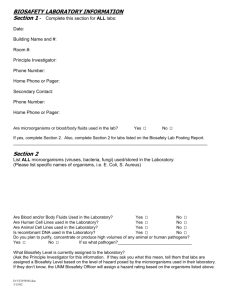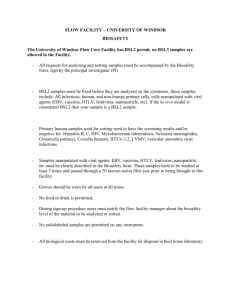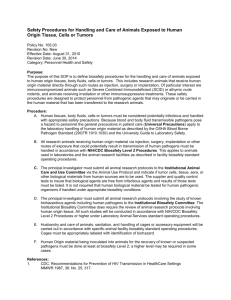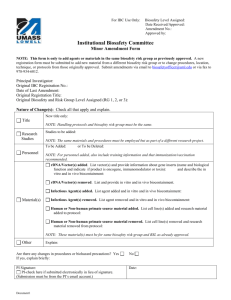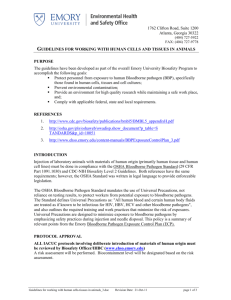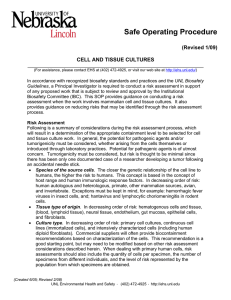Cell Culture - University of South Alabama
advertisement
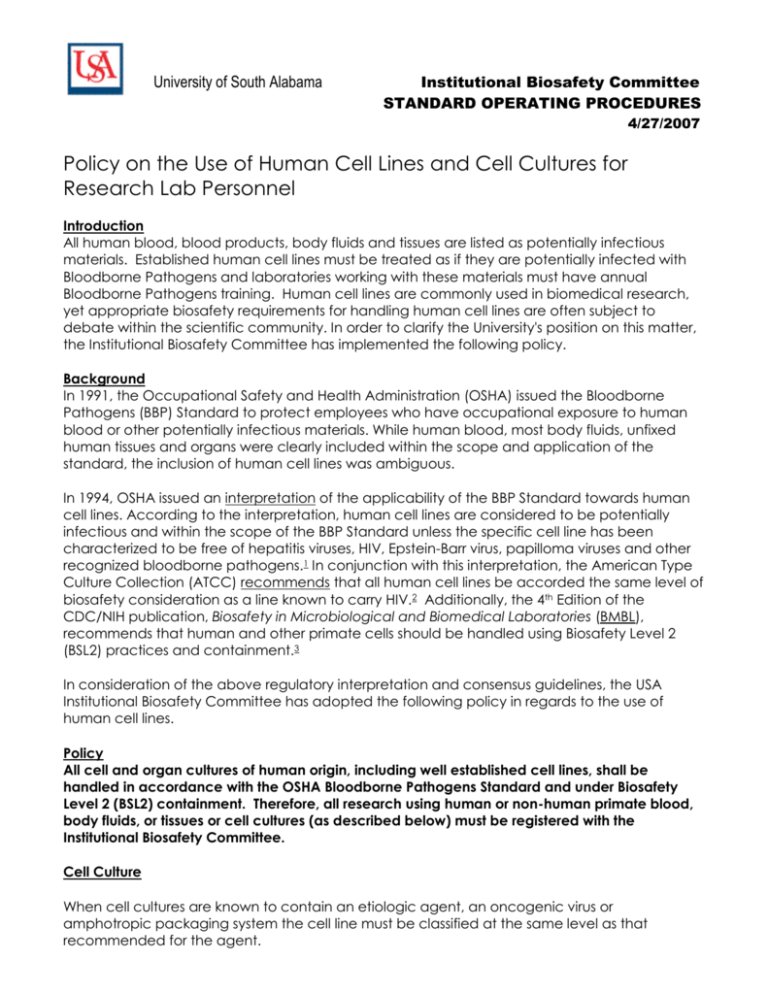
University of South Alabama Institutional Biosafety Committee STANDARD OPERATING PROCEDURES 4/27/2007 Policy on the Use of Human Cell Lines and Cell Cultures for Research Lab Personnel Introduction All human blood, blood products, body fluids and tissues are listed as potentially infectious materials. Established human cell lines must be treated as if they are potentially infected with Bloodborne Pathogens and laboratories working with these materials must have annual Bloodborne Pathogens training. Human cell lines are commonly used in biomedical research, yet appropriate biosafety requirements for handling human cell lines are often subject to debate within the scientific community. In order to clarify the University's position on this matter, the Institutional Biosafety Committee has implemented the following policy. Background In 1991, the Occupational Safety and Health Administration (OSHA) issued the Bloodborne Pathogens (BBP) Standard to protect employees who have occupational exposure to human blood or other potentially infectious materials. While human blood, most body fluids, unfixed human tissues and organs were clearly included within the scope and application of the standard, the inclusion of human cell lines was ambiguous. In 1994, OSHA issued an interpretation of the applicability of the BBP Standard towards human cell lines. According to the interpretation, human cell lines are considered to be potentially infectious and within the scope of the BBP Standard unless the specific cell line has been characterized to be free of hepatitis viruses, HIV, Epstein-Barr virus, papilloma viruses and other recognized bloodborne pathogens.1 In conjunction with this interpretation, the American Type Culture Collection (ATCC) recommends that all human cell lines be accorded the same level of biosafety consideration as a line known to carry HIV.2 Additionally, the 4th Edition of the CDC/NIH publication, Biosafety in Microbiological and Biomedical Laboratories (BMBL), recommends that human and other primate cells should be handled using Biosafety Level 2 (BSL2) practices and containment.3 In consideration of the above regulatory interpretation and consensus guidelines, the USA Institutional Biosafety Committee has adopted the following policy in regards to the use of human cell lines. Policy All cell and organ cultures of human origin, including well established cell lines, shall be handled in accordance with the OSHA Bloodborne Pathogens Standard and under Biosafety Level 2 (BSL2) containment. Therefore, all research using human or non-human primate blood, body fluids, or tissues or cell cultures (as described below) must be registered with the Institutional Biosafety Committee. Cell Culture When cell cultures are known to contain an etiologic agent, an oncogenic virus or amphotropic packaging system the cell line must be classified at the same level as that recommended for the agent. Furthermore, the following must be handled at Biosafety Level 2 or higher containment level: All cell lines of human/primate origin Any cell lines derived from lymphoid or tumor tissue All cell lines exposed to or transformed by any oncogenic virus All cell lines exposed to or transformed by amphotropic packaging systems All clinical material (e.g., samples of human tissues and fluids obtained after surgical resection or autopsy) All cell lines new to the laboratory (until proven to be free of all adventitious agents) All mycoplasma-containing cell lines References 1. OSHA Letter of Interpretation, URL: http://www.osha.gov/pls/oshaweb/owadisp.show_document?p_table=INTERPRETATIONS &p_id=21519 2. American Type Culture Collection Frequently Asked Questions, URL: http://www.atcc.org/TechnicalInfo/faqCellBiology.cfm#Q53 3. Biosafety in Microbiological and Biomedical Laboratories, 4th Edition, URL: http://www.bmbl.od/nih.gov
